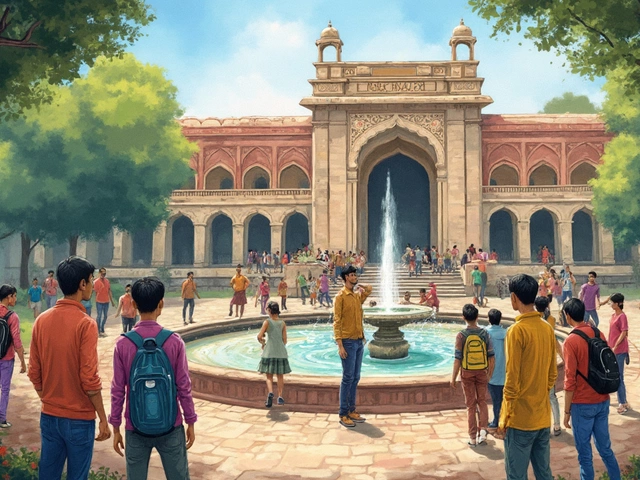Ever felt like cracking an IIT is a bit like winning the lottery, except you trade ticket numbers for sleepless nights and stacks of books? You’re not alone. Every year, almost a million students take on the JEE Advanced challenge, but fewer than 2% get that golden ticket—an IIT seat.
The first thing you should know: not all IITs are created equal. Some have legendary status, fierce popularity, and heartbreaking competition—while others are easier to get into. But which IIT tops the difficulty charts? If you care about where the biggest crowds fight for a few seats, you’ll want to check out actual data, not just tall tales from relatives or coaching teachers.
In this deep dive, you’ll see real stats on closing ranks, why certain IITs (hint: Bombay and Delhi) attract the most attention, and what that means for your odds. There’s more to this battle than big city lights. The campus vibe, placement history, and course choices all play a huge part. Plus, some sharp tips to help you aim smarter, not just harder, are packed right ahead.
- Why IITs Are So Competitive
- The Real Numbers: Closing Ranks and Seats
- What Makes an IIT 'Hard' to Get Into?
- IIT Bombay vs. Others: The Popularity Battle
- How Toppers Choose Their IITs
- Actionable Tips for IIT JEE Aspirants
Why IITs Are So Competitive
When you hear people talk about the chaos of IIT JEE prep, there’s a real reason behind the hype. Getting into any IIT isn’t just tough—it’s like getting through a door that a thousand hands are reaching for at once. In 2024, over 1.2 million students registered for the JEE Main exam, the gateway before you even reach JEE Advanced, which is the actual test for IITs. Out of these, only around 170,000 students got to sit for JEE Advanced, and less than 18,000 finally grabbed a spot in one of the IITs across India.
Why are so many students fighting for so few seats? Simple. IITs offer the kind of career boosts most colleges can’t match: amazing campus placements with big tech companies, research opportunities with top scientists, and global recognition that opens doors everywhere. Even if you’re not a genius, just having 'IIT' on your resume can change your life.
Here are some reasons the competition is so intense:
- Limited Seats: With 23 IITs sharing about 18,000 seats between them, you do the math. It’s crowded.
- Prestige: Every parent, teacher, and neighbor sees an IITian as league apart. This pressure alone packs out the exam halls every year.
- Job Opportunities: IITians regularly get job offers from Google, Microsoft, and other global companies—even during big hiring freezes elsewhere.
- Global Reputation: IIT degrees are recognized and respected abroad. Going to a top IIT can be your ticket to a great career overseas.
Here’s a quick look at how the seats and applicants stack up:
| Year | JEE Main Applicants | Advanced Eligible | IIT Seats |
|---|---|---|---|
| 2024 | 1,200,000 | 170,000 | 18,000 |
| 2023 | 1,100,000 | 160,000 | 17,400 |
The bottom line? With jaw-dropping competition and the promise of a lifetime’s worth of opportunities, it’s no wonder parents and students lose sleep over those rolling JEE results.
The Real Numbers: Closing Ranks and Seats
If you’re weighing which IIT is the hardest to get into, just look at the closing ranks and the number of seats—it’s the real litmus test. The “closing rank” is basically the rank of the last person who made it into a particular IIT and branch that year. Lower closing rank means tougher competition—simple as that.
Let’s get specific. For the Computer Science and Engineering (CSE) branch, which is every topper’s dream, IIT Bombay usually tops the charts. In JEE Advanced 2024, the closing rank for CSE at IIT Bombay was 66 (open category), while IIT Delhi followed close with a closing rank of 112. Compare that to IIT Guwahati, where it’s around 600. That’s a massive gap!
| IIT | CSE Closing Rank 2024 (Open Category) | Total CSE Seats |
|---|---|---|
| IIT Bombay | 66 | 123 |
| IIT Delhi | 112 | 124 |
| IIT Madras | 177 | 107 |
| IIT Kharagpur | 286 | 157 |
| IIT Kanpur | 238 | 121 |
| IIT Guwahati | 600 | 89 |
So, more seats don’t always mean easier admission. For example, IIT Kharagpur has more CSE seats than Bombay, but you still need a much higher rank to get into Bombay. Students chase not just the branch, but also the brand and campus life.
Also, the number of total seats across all branches in older IITs is roughly 900-1200 each, while newer IITs might offer just 300-500. Tougher competition usually clusters around old IITs with limited “hot” seats.
It’s tempting to only look at closing ranks for Computer Science, but even for other top branches like Electrical or Mechanical, the pattern holds—those lowest closing ranks stick to Bombay and Delhi.
If you’re eyeing the holy grail—Computer Science at IIT Bombay or Delhi—you’re basically fighting for one of just a hundred or so seats against the entire top batch of IIT JEE aspirants. The numbers are ruthless, but knowing them helps you plan where your best shot lies.
What Makes an IIT 'Hard' to Get Into?
When people talk about the hardest IIT to get into, they usually mean the one that’s most popular among top JEE scorers. But there’s more to the story than just the rank cutoffs. A bunch of different factors work together to make some IITs extra tough—almost like a perfect storm for competition.
- Number of Seats: Each IIT has a different number of available seats for each branch. The fewer the seats, the sharper the fight. For example, Computer Science at IIT Bombay usually has less than 120 seats—that’s tiny compared to the nationwide demand.
- Closing Ranks: The closing rank shows the cutoff for the last student who got in. The lower the closing rank, the more competitive it is. Take IIT Bombay CSE again: the closing rank often hovers around AIR 60 to 70. That’s wild when you think about a million applicants!
- Popularity: Thanks to its location in Mumbai, placement records, alumni connections, and vibrant campus life, IIT Bombay’s CSE is almost always first pick for toppers. IIT Delhi, IIT Madras, and IIT Kanpur follow right behind with fierce competition in their top branches.
- Branch Demand: Not every department is equally sought after. In almost every IIT, Computer Science and Electrical Engineering grab the limelight, with seats snatched up by toppers, while other departments tend to have less pressure.
- Category Reservations: If you’re in a reserved category (like SC, ST, OBC, EWS), the number of seats and closing ranks vary compared to general category students. So, difficulty fluctuates based on category, too.
Here’s a snapshot to show how tough the top IITs’ Computer Science seats are, using last year’s closing ranks for the Open (General) category:
| IIT | CSE Closing Rank |
|---|---|
| IIT Bombay | 67 |
| IIT Delhi | 118 |
| IIT Madras | 175 |
| IIT Kanpur | 238 |
| IIT Kharagpur | 304 |
So, when students say "IIT Bombay CSE is impossible," it’s not just hype. The facts back it up. But remember, the word "hard" means something different for each aspirant—it depends on the branch you want, your category, and your own strengths. If you’re aiming for IIT JEE and dreaming about these top spots, it helps to check the current stats before you plan your moves.

IIT Bombay vs. Others: The Popularity Battle
If you ask around at any Kota hostel or coaching center, you’ll hear plenty of kids say, “I want to go to IIT Bombay.” But why is IIT Bombay topping almost everyone’s list, sometimes even beating legendary names like IIT Delhi and IIT Kanpur?
The answer is a mix of vibe, placements, and hard numbers. Historically, IIT Bombay has had some of the lowest closing ranks in JEE Advanced. For Computer Science (B.Tech CSE), getting in usually takes an All India Rank (AIR) in the top 60–70. Yup, top 0.01% of all candidates. No pressure, right?
| IIT | Closing Rank |
|---|---|
| IIT Bombay | 67 |
| IIT Delhi | 118 |
| IIT Madras | 175 |
| IIT Kanpur | 237 |
The crazy-low closing rank at IIT Bombay isn’t just about brand value. The city, the campus culture, and booming placements (especially for tech and core branches) pull top scorers directly toward it. If you’re dreaming about a Google or Microsoft interview right from the campus, Bombay’s track record looks pretty tempting.
Don’t forget location. Mumbai has the edge for internships and job networking, with big companies right in its backyard. Compare this with, say, IIT Guwahati or IIT Roorkee, where placements are good but not as superstar-packed—or as convenient, location-wise.
Among all the old IITs, Delhi and Madras are strong rivals. Kids aiming for CS or Electrical sometimes waver between Bombay and Delhi. But overall, preferencing data shows that more toppers lock in IIT Bombay as their first choice, sometimes even picking lower branches in Bombay over CS in other IITs.
So, if you want an honest answer to “Which IIT is the hardest to get into?”—it’s right here. Statistically and by preference, IIT Bombay holds the crown, especially for top courses. If you’re eyeing a seat here, you are definitely not alone in that boat.
How Toppers Choose Their IITs
Everyone thinks toppers just pick whichever IIT shows up first on their result page, but it’s way more strategic. These students know the power of every little detail, so their decision-making is sharp and based on years of trends and solid advice—not just shiny brochures.
For most toppers, IIT Bombay is the dream pick, especially for Computer Science. Why? The campus life is legendary, Mumbai opens up crazy good internships, and their past placements break records. Look at the closing ranks: the highest All India Ranks (AIRs) usually choose IIT Bombay CSE. If you peek at JEE 2024 stats, the last general category rank for IIT Bombay CSE stopped at around 66. That's pretty intense.
| IIT | Branch | 2024 Closing Rank (General Category) |
|---|---|---|
| IIT Bombay | CS | 66 |
| IIT Delhi | CS | 104 |
| IIT Madras | CS | 185 |
| IIT Kanpur | CS | 238 |
But not everyone is after CSE or Bombay. Some toppers look at faculty research, international tie-ups, or even the vibe—Delhi gets picked by students who want startup exposure and love city life. Madras attracts those interested in research or its unique programs. Kanpur, with its strong alumni network and focus on innovation, is also a solid favorite for some streams.
Other reasons toppers pick a particular IIT or branch:
- Special programs or dual degrees that set resumes apart
- Specific research labs or professors (yes, some know this even before joining)
- Strong alumni network for internships and jobs
- Flexible course structure—Bombay and Delhi are favorites here
- Location and city perks (think airport access, startup culture, or weather)
What’s wild is how some high rankers will even pick a slightly less popular IIT for their dream branch or a special interest, because long-term goals matter more than just campus name. The takeaway? If you’re in the race for a hardest IIT or a top branch, bring out your inner researcher. Dig up placement stats, talk to current students, and make your decision fit you—not just what everyone else is doing.
Actionable Tips for IIT JEE Aspirants
Let’s get straight to what actually helps when you’re eyeing that IIT JEE seat, especially at the hardest IITs like Bombay or Delhi.
- Don’t blindly follow trends: Everybody wants to crack IIT Bombay or Delhi, but your best-fit IIT and branch might be elsewhere. Focus more on the closing ranks, not the big brand alone.
- Check last year’s cutoffs: Every year, the closing ranks for Computer Science at Bombay and Delhi demand All-India ranks under 70-100. For slightly less competitive branches, the cut-offs ease up a bit, but never underestimate seat crunch.
- Manage your time like a pro: High scorers often swear by strict timetables and consistent revisions—not last-minute cramming. Set realistic targets for daily and weekly revision.
- Mock tests are your best friend: Most toppers take at least 20 full-length mock tests in the last three months. Analyze your mistakes after every test; don’t just focus on the scores.
- Stay mentally fit: It’s easy to burn out after months of prep. Small breaks, quick chats with friends, even a walk with your dog (shout out to Bella for keeping me calm during my own exam days), do wonders for your focus and anxiety.
- Use reliable sources only: Stick to study material from trusted coaching centers or NCERTs for core concepts. Bouncing between YouTube ‘shortcuts’ and different books only causes confusion.
- Target accuracy, not just attempt count: In JEE Advanced, wild guessing can kill your score. Top ranks go to those with fewer mistakes, not just those who ticked all boxes.
If you’re curious how tough the competition really is, check out this simple breakdown of 2024 JEE Advanced numbers for the top IITs:
| IIT | General Seat Intake | Top Rank for CSE |
|---|---|---|
| IIT Bombay | 110 | 67 |
| IIT Delhi | 110 | 121 |
| IIT Madras | 114 | 175 |
You can see how razor-thin the margin is, especially for Computer Science at the most popular IITs. So, focus on gradual, stress-managed improvement instead of just dreaming about one institute. Sometimes your best shot is a high rank plus a strategic branch choice—not just chasing a fancy city name.





